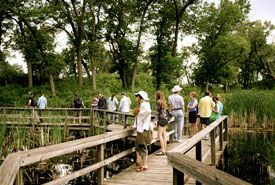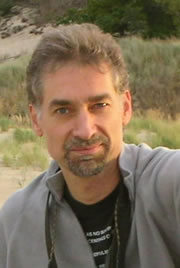How to soundwalk (Part One)

Soundwalk in Miller Woods, Indiana Dunes National Lakeshore, July 2010. (Photo by Noé Cuéllar)
The first soundwalk I ever led may have been my most memorable. Serendipity created a choice moment as my group crossed the reedy marsh of Miller Woods in the Indiana Dunes, while the loud drone of prop-driven airplanes from the Gary Air and Water Show streamed heavily above. It was July and rain clouds loomed. In the shady wooded area mosquitoes were feasting on us. I worried that this soundwalk would be a small debacle as I slapped another fat mosquito.
When we arrived at the boardwalk spanning across the marsh, the open area discouraged the mosquitoes from pursuing us and the air show suddenly took an intermission. A sense of calm, and for me relief, descended. As we stood silently, frogs began clicking and chirping. Birds joined in and you could say "nature’s symphony" began. The varied mix of animal sounds was a source of tranquility and curiosity for the group who came to quiet, still attention — surrounded by shifting reeds and trees, silently dissipating clouds and pockets of blue sky opening overhead — listening.
In his book, Hear Where We Are: Sound, Ecology, and Sense of Place, author Michael Stocker said, "Sound is the physical signature of our dynamic surroundings. Things that move produce it; things that don’t nonetheless impinge on it…for sound to exist something has to happen."
"Sound tells us where we are," I remember author and MIT Professor Emeritus Barry Blesser saying to a group of sound ecologists. Yet when it comes to listening to the message of the place where we are, few ever do. Text and images are instantaneous inputs; we pride ourselves on the speed with which we can train ourselves to process them sequentially. In contrast, a soundwalk compels its participants to slow down and listen to layers of information simultaneously. Vocalizing birds, trees activated by wind, the ringing in one’s ears, the approaching roar of a passenger jet — one, many, or all these commonplace sounds are part of my daily urban soundscape; maybe yours, too.
Over the years, I have gone on to lead scores of soundwalks with my students at the School of the Art Institute of Chicago and for the public with the Midwest Society for Acoustic Ecology. The transformative power of a soundwalk may resemble a performance, a celebration or a meditation for groups and can include intentional elements that focus the experience in a particular way. Staging actors or musicians along the route has provided an interesting experience on some soundwalks.
Blind walks accentuate the experience greatly as they require complete surrender to our often atrophied senses of hearing and touch. Keeping one’s eyes shut with an arm clasped through the arm of a guide can be quite exciting, but may be surprisingly stressful for the blindfolded soundwalker. The sensation of "reaching out" with your ears as sources of sounds approach and pass from any direction, slowly or suddenly, one at a time or all at once, makes walking through even a familiar environment intense. The blind soundwalker may feel quite uncomfortable, vulnerable and hyper-vigilant. This state of mind means a pair or a group of organized participants must construct an important person-to-person ingredient for soundwalking: trust.
Canadian composer and the "mother of acoustic ecology," Hildegard Westerkamp, wrote, "A soundwalk is any excursion whose main purpose is listening to the environment. It is exposing our ears to every sound around us no matter where we are."
Reading about soundwalks helps, but only with active participation can its full meaning be felt. Doing a soundwalk is the best way to understand what it is and its importance. Disgusted by a gentrifying urban neighborhood I had once lived in, leading a soundwalk through the hustle and bustle of its Saturday night bar scene, weaving away to quieter side streets and back again into the fray was revelatory for me. I discovered that the streets were sonic pathways similar to movements of a structured improvisation; a physical and spatial score in which I could lead my listening audience while the scene played on. We, a silent group of actively listening walkers, created an unusual and unexpected presence as we passed through the crowded streets.
As an ecological practice, soundwalking can be an entertainment or a method of inquiry, a call to action or a meditation. Soundwalks can play multiple roles all at once or shift intents from moment to moment. Deep, active listening can enrich and stimulate creative responses in day-to-day life, as well as inform the design of our built environment. Soundwalking can encourage greater care and respect for natural soundscapes as a part of human soundscapes, and awareness of how human soundscapes impact natural soundscapes.
Stay tuned for Part Two of this post on Oct. 28 where I will talk about how to lead a soundwalk!
References
Megalópolis sonoras: Identidad cultural y sonidos en peligro de extinción (Sound Megalopolis: Cultural Identity and Sounds In Danger of Extinction) 23-27 March 2009 World Forum for Acoustic Ecology conference at Fonoteca Nacional, Mexico City.


